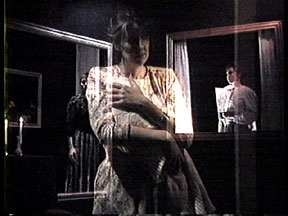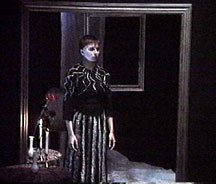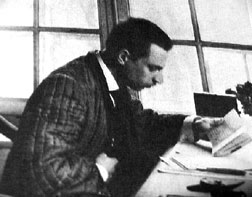ParaTheatrical
ReSearch
presents
Rainer
Maria Rilke's
REQUIEM
FOR A FRIEND

A
VideoPoem by
Antero Alli (1991)
the Stephen Mitchell translation
ParaTheatrical
ReSearch
presents
Rainer
Maria Rilke's
REQUIEM
FOR A FRIEND

A
VideoPoem by
Antero Alli (1991)
the Stephen Mitchell translation
|
I have my dead, and I have let them go, and
was amazed to see them so contented, so soon
at home in being dead, so cheerful, so unlike
their reputation. Only you return;
 |
brush past me, loiter, try to knock against something, so that the sound reveals your presence. Don't take from me what I am slowly learning. |
|---|---|
|
So begins Rilke's tribute to the accomplished painter and friend, Paula Modersohn-Becker, who died unexpectedly eighteen days after the birth of her first child. Rilke's epic lament serves as the narrative for this video docudrama of a paratheatre performance staged at The Bell Gallery, in Seattle WA, during October of 1990. REQUIEM: the videopoem presents a visual montage of a woman who, after the shock of her own death, is caught in a haunted bardo where a ritual enactment of her three-fold self -- artist, mother, and soul torn between -- unfolds. |
|
|
"Once ritual lament would have been chanted; women would have been paid to beat their breasts and howl all night, when all is silent. Where can we find such customs now ?" |
|
|
REQUIEM
FOR A FRIEND
(1991; 40:00) Featuring KIA SIAN, CAMILLE HILDEBRANDT, JADINA LILIEN. Soundtrack by SYLVI ALLI. Spoken, directed & edited by ANTERO ALLI. John Comerford, assist. editor. Produced by ParaTheatrical ReSearch. (1991, 41 min. USA) |
|
|
| |
Rainer
Maria Rilke and Paula Modersohn-Becker
Czech poet Rainer Maria Rilke (1875-1926) wrote “Requiem for a Friend” (1909) as a tribute to good friend and established painter, Paula Modersohn-Becker (1876-1907) who died suddenly eighteen days after birthing her first child at the peak of her artistic development. Amost a year after Paula's tragic death, Rilke wrote his epic lament over three days and nights (Oct. 31 through Nov. 2, 1908) alone in a room at the Hotel Biron in Paris; it was published in 1909. Paulas' death continued to haunt Rilke's life for most of his remaining years.

Rainer
Maria Rilke in 1908; Hotel Biron
"...I'm sure you have gone astray if you are moved to homesickness for anything in this dimension. We transform these Things; they aren't real, they are only the reflections upon the polished surface of our being. I thought you were much further on. It troubles me that you should stray back, you... who have achieved more transformation than any other woman. That we were frightened when you died...no; rather: that your stern death broke in upon us... darkly... wrenching the till-then from the ever since -- this concerns us: setting it all in order is the task we have continually before us..."
from "REQUIEM FOR A FRIEND"
click above link for the text in its entirety
Kia Sian as "mother" and Jadina
Lilien as "artist"
mother,
artist and soul torn between
In both performance and video, our
premise was to enact a ritual lament involving three
women symbolizing three facets of Paula --
the mother, the artist and the soul
torn between -- interacting with
and reacting to the shock of her own death. Originally
staged at The Bell Gallery (Seattle) in October of
1990 as a live paratheatre performance, (with my then-partner,
a very pregnant Camille Hildebrandt as "mother",
my unforeseen future partner Cyndia Pickering as "soul
torn between" and my good friend Jadina Lilien
as "the artist"), "Requiem" was
videotaped eight months later in a soundstage studio
(with Kia Sian portraying "the mother",
Camille as "soul torn" and Jadina as "artist").
The
Set; a window, a mirror, a
frame
All
three women are simultaneously undergoing their own
distinct ritual within a physical set of one very
large black wall (40ft wide x 8ft high), through which
each woman is seen behind her own large framed opening:
the mother rocks an infant to sleep (within
a large painting frame), the artist creates
a painting (as seen through a large window) and the
soul torn between slowly unfolds an abstract dance
of death (inside a large "mirror"). The
two wings of this wall -- mother and artist -- are
slanted towards the audience, allowing all three women
to see each other, with the soul torn in the middle.
The
Video Production; shooting and editing at the same
time
The day before shooting I told the
camera operators to view and closely study Andrei
Tarkovsky's film, "The Mirror", as a visual
and pacing reference: the ultra-slow pans, creeps,
and crawls; the locked down long shots. The next day
we shot the performances with three cameras (pro 3/4" SP) and a switcher (w. four video monitors) enabling
us to edit live on site as the cameras rolled. After
hours of working to get the lights just right, shooting
began. Miraculously, we got everything on the first
take (all three cameras never stopped rolling for
35 minutes!).
Over the following weeks, we recorded my reading of Rilke's words and mixed that voice-over with an original soundtrack composed and performed by Sylvi Alli. I also added half a dozen video inserts (shot in various locations) before the final cut, my debut video, premiered in Autumn of 1991 at 911 Media Arts Center in Seattle. Since then, "Requiem" has regretfully gone the way of obscurity, screening only five or six times since its opening night. (The video still exists as an exhibition piece but is not available for sale at this time)
The
Life/Art Mirror
These
staged and video productions foreshadowed a fate far
greater than
any artistic achievement or critical acclaim. Camille
Hildebrandt gave birth to our first daughter, Zoe,
on January 4, 1991 who, after twenty months of bringing
us nothing but joy, suddenly died. In the wake of
our tragedy, Rilke's words provided me with unforeseen
solace and insight. Following my own lament over Zoe's
passing, I have slowly come to see more in his "Requiem" than a story of death and loss. Though certainly that
is there, I am now facing something in the core of
Rilke's own faith and convictions that have been guiding
and resurrecting my own life ever since my daughter's
death and, perhaps all along. It seems that death
brings gifts, as well.
"THE GREATER CIRCULATION"
the
2005 feature film by Antero Alli
incorporating Rilke's "Requiem
"
click
above image for details